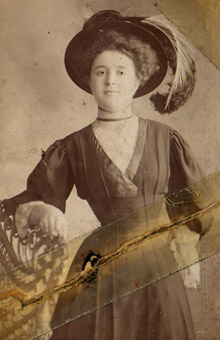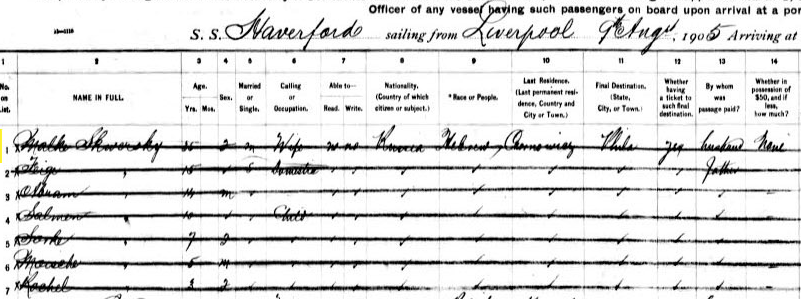
This picture of my great-grandmother Feige (later Fanny) is one of the heirlooms I treasure most. When my grandmother, her youngest child, was alive, it had pride of place in her apartment, and I used to stare at it for long stretches, imaging the life of the woman with the beautiful, plumed hat. This photograph was probably taken when Fanny was in her late teens, only a few years after she immigrated from Russia to Philadelphia at age 15. But she almost didn’t make it!
Her father arrived in Philadelphia in late 1901 and worked for three-and-a-half years before he bought tickets on 5/3/1905 for his wife, his eldest daughter Feige, and Feige’s five brothers and sisters to join him. The Skversky family traveled from their hometown to Hamburg, and on 8/5/1905 they sailed from Hamburg to Grimsby then took a train to Liverpool. They were then supposed to have boarded a ship on on 8/9/1905 to take them to Philadelphia. But this is the ship manifest I found for that journey:

I was unsure what it meant that their names were crossed off until I found this second manifest from a week later, also for a Liverpool to Philadelphia journey:

I now understood that the family must have belatedly changed their minds about the first ship. But why? A closer look at the second passenger list shows a problem that begins to unravel the mystery: There are only five children with my great-great-grandmother, Malke! Fanny is missing!
These manifests are frustratingly mute about this traumatic chapter in my family’s history. Why was Fanny left behind? My first instinct was that she had gotten too sick to travel. Perhaps it was too expensive for her mother and five siblings to remain with her while she recovered. Did they expect she would recover? I dwelt on the heart-breaking possibly that when they parted, they might not have known if they would ever see each other again. Genealogy friends suggested a less fraught scenario: she had to stay to work to pay for her fare. Though a common occurrence, I doubted this possibility in Fanny’s case, since I had the receipt for all the tickets her father purchased:

This receipt for the tickets my great-great-grandfather purchased to bring his family over comes from the Rosenbaum Bank Passage Order Book records.
My first guess turned out to be right. The real story eventually came out via my mother’s second cousin, Rhea, daughter of Fanny’s sister Sarah. She had heard that the family had had to leave someone behind in Liverpool due to illness—but Rhea thought it was her grandmother! As with so many family stories, the kernel of this story was true, if not the specifics.
Obviously Fanny made it to Philadelphia, where I know she married Abe of the “severed” pinky and lived the rest of her happy life. But when did she arrive? It took me a while to find her listing, because her last name was misspelled. It turns out she departed on 11/29/1905, two and a half months after her mother and siblings left her, arriving in Philadelphia 107 years ago today!
High on my list of genealogy mysteries to solve is exactly what happened to Fanny during the long months when she was apart from her family. After years of being told that no relevant records survive, hope finally came via Saul Marks, an expert on Jewish genealogy in Liverpool. He writes:
In answer to your query, I can’t imagine there would be many records at all of Fanny’s few months here in Liverpool. As a child, she wouldn’t have joined a synagogue & she wouldn’t have been listed in trades directories or electoral rolls. She may have lodged somewhere but I suspect that the most obvious place she stayed would have been the workhouse infirmary. There are admission & discharge records held by Liverpool Record Office for the former workhouse on Brownlow Hill, so we could investigate these.
Unfortunately the Liverpool Record Office is in the process of moving facilities, so their records will not be available to researchers until May 2013. In the meantime, the woman in the plumed hat keeps the answers to herself.
 Follow
Follow
Absolutely love your site — you are a great storyteller! I am particularly intrigued because you are showing us something new: how to take the “dry” documents that we are researching and reveal the vibrant, living people they represent.